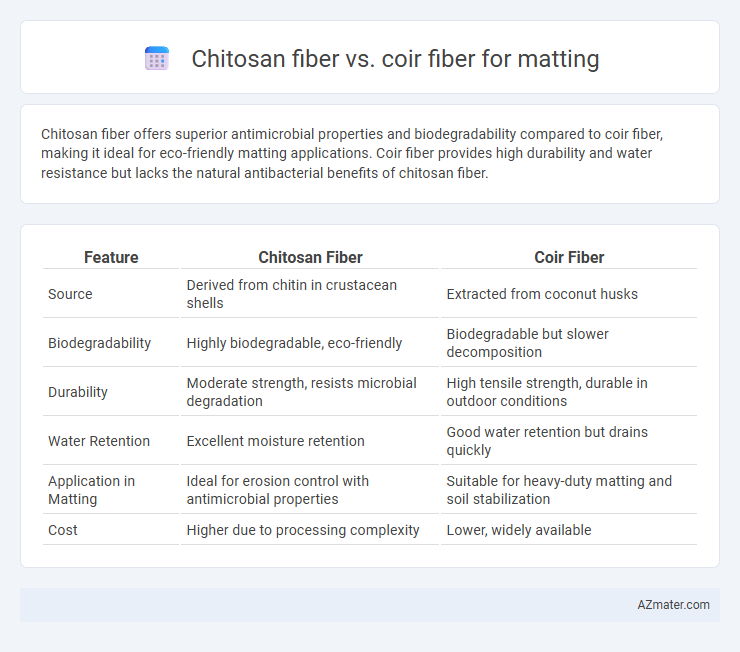Chitosan fiber offers superior antimicrobial properties and biodegradability compared to coir fiber, making it ideal for eco-friendly matting applications. Coir fiber provides high durability and water resistance but lacks the natural antibacterial benefits of chitosan fiber.
Table of Comparison
| Feature | Chitosan Fiber | Coir Fiber |
|---|---|---|
| Source | Derived from chitin in crustacean shells | Extracted from coconut husks |
| Biodegradability | Highly biodegradable, eco-friendly | Biodegradable but slower decomposition |
| Durability | Moderate strength, resists microbial degradation | High tensile strength, durable in outdoor conditions |
| Water Retention | Excellent moisture retention | Good water retention but drains quickly |
| Application in Matting | Ideal for erosion control with antimicrobial properties | Suitable for heavy-duty matting and soil stabilization |
| Cost | Higher due to processing complexity | Lower, widely available |
Introduction to Chitosan and Coir Fibers
Chitosan fiber, derived from chitin found in crustacean shells, offers exceptional biodegradability, antimicrobial properties, and strong moisture absorption, making it suitable for eco-friendly matting applications. Coir fiber, extracted from coconut husk, is renowned for its natural durability, water resistance, and coarse texture, commonly used in traditional matting and erosion control. Both fibers provide sustainable alternatives but differ significantly in their source materials, physical characteristics, and environmental impact in matting products.
Source and Production Methods
Chitosan fiber is derived from chitin found in crustacean shells, primarily from shrimp and crab exoskeletons, through processes like deacetylation and fiber spinning that convert crustacean waste into biodegradable fibers. Coir fiber originates from the husk of coconut fruits, harvested and mechanically or manually extracted before undergoing retting and drying to produce coarse, stiff fibers suitable for matting. The production of chitosan fiber involves chemical treatments to enhance fiber properties, whereas coir fiber production relies on mechanical extraction and natural retting, reflecting differences in raw material composition and processing complexity.
Physical and Mechanical Properties
Chitosan fiber exhibits superior tensile strength and elasticity compared to coir fiber, making it more durable for matting applications. Coir fiber offers higher abrasion resistance and natural water repellency, enhancing its performance in wet or outdoor environments. Both fibers demonstrate good biodegradability, but chitosan's antimicrobial properties provide added functionality in mats requiring hygiene and odor control.
Environmental Impact and Sustainability
Chitosan fiber, derived from chitin in crustacean shells, offers excellent biodegradability and antimicrobial properties, making it a highly sustainable choice for matting compared to coir fiber, which is extracted from coconut husks and is also biodegradable but slower to decompose. The production of chitosan fiber utilizes seafood waste, reducing environmental impact by repurposing byproducts, while coir fiber cultivation relies on coconut farming, which can involve deforestation and water usage concerns. Both fibers contribute to reducing plastic use in matting applications, but chitosan fiber's enhanced antimicrobial nature and faster breakdown rate position it as a more eco-friendly option for environmentally conscious consumers.
Biodegradability and Compostability
Chitosan fiber exhibits superior biodegradability and compostability compared to coir fiber due to its natural polysaccharide structure derived from chitin, which decomposes rapidly in soil environments. Coir fiber, sourced from coconut husks, is also biodegradable but decomposes more slowly because of its lignin and cellulose content that resists microbial breakdown for extended periods. When used for matting, chitosan fiber mats offer faster soil integration and nutrient recycling benefits, making them ideal for applications requiring quick environmental assimilation.
Performance in Erosion Control Matting
Chitosan fiber exhibits superior biodegradability and antimicrobial properties, enhancing soil stabilization and reducing microbial degradation in erosion control matting compared to coir fiber. Its finer fiber structure improves soil contact and moisture retention, promoting faster vegetation growth essential for effective erosion control. Coir fiber, while durable and water-retentive, tends to degrade slower, providing longer-term protection but with less impact on immediate vegetation establishment.
Water Retention and Absorption Capabilities
Chitosan fiber exhibits superior water retention and absorption capabilities compared to coir fiber due to its hydrophilic nature and porous structure, enabling it to hold moisture effectively. Coir fiber, derived from coconut husks, offers moderate water absorption but tends to dry faster because of its coarse texture and lower porosity. In matting applications, chitosan fiber's enhanced moisture retention makes it ideal for environments requiring sustained hydration, while coir fiber's faster drying properties benefit settings needing quicker drainage.
Cost Analysis and Market Availability
Chitosan fiber, derived from crustacean shells, typically incurs higher production costs due to complex extraction and processing, making it less economically viable than coir fiber for large-scale matting applications. Coir fiber, sourced from coconut husks, offers a cost-effective alternative with widespread market availability, benefiting from established supply chains and lower raw material costs. Despite the premium price, chitosan fiber provides added antimicrobial properties and biodegradability, whereas coir fiber remains the dominant choice in the market due to affordability and accessibility.
Applications in Landscaping and Agriculture
Chitosan fiber offers superior biodegradability and antimicrobial properties, making it ideal for erosion control mats that enhance soil health and promote plant growth in landscaping and agriculture. Coir fiber, derived from coconut husks, provides excellent water retention and durability, commonly used for durable mats in landscaping projects to stabilize soil and support seed germination. Both fibers serve as sustainable options, but chitosan fiber is preferred where microbial resistance and faster decomposition enhance agricultural productivity.
Conclusion: Which Fiber is Best for Matting?
Chitosan fiber offers superior durability, antimicrobial properties, and biodegradability compared to coir fiber, making it highly suitable for high-traffic matting applications. Coir fiber excels in natural water resistance and cost-effectiveness, but its rough texture and lower longevity limit its performance in demanding environments. For premium, long-lasting matting with added hygienic benefits, chitosan fiber stands out as the best choice.

Infographic: Chitosan fiber vs Coir fiber for Matting
 azmater.com
azmater.com